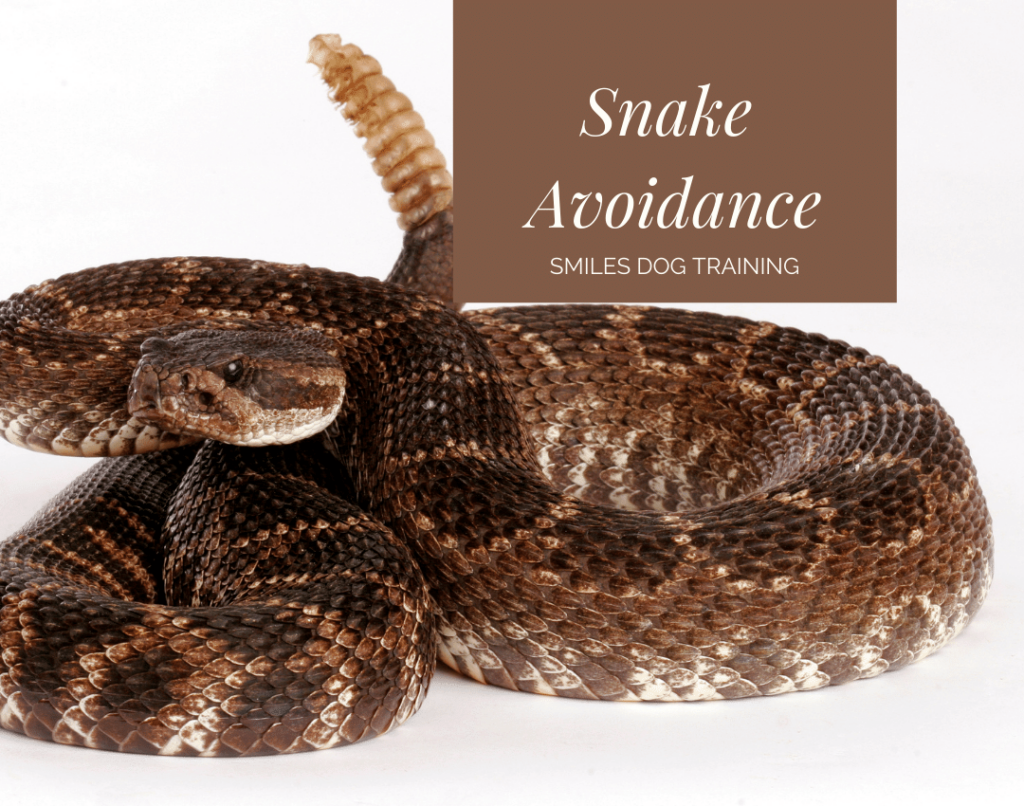It’s officially that time of year again. Spring is here and this means that many trainers in the valley are promoting “Snake Avoidance Training” workshops. While it may seem like a good idea to sign up for one of these short workshops, Smiles Dog Training wants pet parents to understand why these workshops are often more trouble than they are worth.
Yes, it hurts!
Snake Avoidance Training workshops are usually done by trainers using shock (electronic) collars. The concept is that the dog will receive an electric shock when it smells/sees/hears a snake and make a negative association with the snake going forward. The electric shock does need to be scary and/or painful enough for your dog to make a negative association, and this varies by each individual dog – otherwise, it is not effective in creating a negative association. Think about static electricity. Often, these shocks are not enough to get us humans to change our behavior. It is only when the static shock is painful and intense that we start looking at ways to avoid it in the future (avoiding that door handle or deciding to get rid of the carpet in the house!). Using pain and fear in training can have devastating effects for animals according to the American Veterinary Society of Animal Behavior and the British Small Animal Veterinary Association.
The dog doesn’t always realize the shock is because of the snake!
The trainer and the owner don’t get to choose what association the dog actually makes. The dog is free to make the negative association between the shock and any of the following: people standing nearby, the container the snake is in, the surface the dog is standing on, another dog in eyesight, the collar itself, words or noises that occur at the same time as the shock (aside from the rattle), or no association at all (why the heck do I keep getting shocked and where is it coming from?!). This is most likely why dogs still get bit by rattlesnakes after going through one of these workshops, and why the workshops often recommend a yearly refresher course. (Even dogs that have actually been bitten by rattlesnakes before don’t always make the connection and get bit again!)
What should your dog DO when they see a snake?
These short workshops don’t usually teach your dog what TO DO when they identify a snake in the environment – which could result in additional danger depending on the dog. If your dog tends to run away from scary things, the presence of a snake may now elicit an extreme flight response right into another danger (oncoming traffic, a cliffside, or simply running away). If your dog tends to bark and move toward scary things (fight response), your dog may now be more likely to show aggressive behaviors toward snakes, which increases the likelihood of getting bitten in the future. Smiles Dog Training supports programs that teach dogs what TO DO in the presence of snakes and other environmental threats, like Tucson’s Building Bonds Training 6-week class on Snake Avoidance using positive reinforcement. Having a dog trained to identify a snake in the environment and then calmly return to you and lie at your feet to signal a snake’s presence can prevent everyone in your group from being bitten.
Focusing only on rattlesnakes creates a false sense of security.
There are SO many other threats to our dogs and cats here in Arizona. In fact, Sonoran desert toads kill more Arizona dogs each year than snakes. Our clients have all had run-ins with javelina, coyotes, birds of prey, coral snakes, tarantulas, scorpions, bobcats, Africanized bees, brown spiders, black widow spiders, and gila monsters. Teaching your dog what to do in a variety of environments with increasing distractions and difficulty can prevent your dog from engaging with dangers in the environment no matter what they are. It’s also important to supervise your dog at home and out in the world.
Be proactive in protecting your dog by having a plan.
- Get pet insurance to help with unexpected costs.
- Hire a professional trainer that focuses on building a strong foundation of skills to keep your dog safe in a variety of environments! Contact us today!
- Know where your nearest emergency vet hospital is and whether they have antivenom.
- Rethink unlimited access to the backyard via a doggie door.
- To remove snakes or other animals from your home, call the Arizona Game and Fish Department. The agency’s “Critter Getter Pest Control” program in the Phoenix area can be reached at (480) 984-2660.



